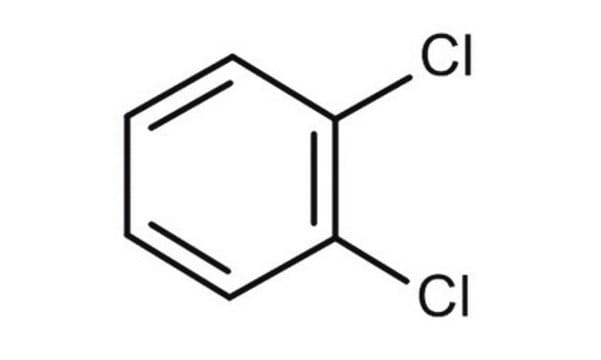270598
1,2-Dichlorobenzene
suitable for HPLC, 99%
About This Item
Polecane produkty
gęstość pary
5.1 (vs air)
ciśnienie pary
1.2 mmHg ( 20 °C)
1.6 mmHg ( 35 °C)
Próba
99%
Postać
liquid
temp. samozapłonu
1198 °F
oczyszczone przez
glass distillation
granice wybuchowości
9.2 %
metody
HPLC: suitable
zanieczyszczenia
<0.020% water
pozostałość po odparowaniu
<0.0005%
współczynnik refrakcji
n20/D 1.551 (lit.)
tw
178-180 °C (lit.)
mp
−18-−17 °C (lit.)
gęstość
1.306 g/mL at 25 °C (lit.)
λ
H2O reference
absorpcja UV
λ: 296 nm Amax: 1.00
λ: 300 nm Amax: 0.30
λ: 305 nm Amax: 0.20
λ: 335 nm Amax: 0.05
λ: 375-400 nm Amax: 0.01
ciąg SMILES
Clc1ccccc1Cl
InChI
1S/C6H4Cl2/c7-5-3-1-2-4-6(5)8/h1-4H
Klucz InChI
RFFLAFLAYFXFSW-UHFFFAOYSA-N
Szukasz podobnych produktów? Odwiedź Przewodnik dotyczący porównywania produktów
Powiązane kategorie
Zastosowanie
- Microstructure regulation and enhanced VOC removal performance of carbon aerogels by surface carbon nanotube grown.: This study presents a new method to enhance the removal of volatile organic compounds, including 1,2-Dichlorobenzene, using surface-modified carbon aerogels (Cheng et al., 2024) (Cheng et al., 2024).
- Role of Electronegativity in Environmentally Persistent Free Radicals (EPFRs) Formation on ZnO.: This research investigates how surface chemistry affects the formation of persistent free radicals, including those from 1,2-Dichlorobenzene on zinc oxide surfaces (Ahmed et al., 2024) (Ahmed et al., 2024).
- Cu(I) Complexes Catalyzed the Dehydrogenation of N-Heterocycles.: This article discusses the application of copper(I) complexes in catalyzing the dehydrogenation of N-heterocycles, including reactions involving 1,2-Dichlorobenzene derivatives (Shen et al., 2024) (Shen et al., 2024).
- New Features of Laboratory-Generated EPFRs from 1,2-Dichlorobenzene (DCB) and 2-Monochlorophenol (MCP).: This publication explores the characteristics of laboratory-generated free radicals from 1,2-Dichlorobenzene, shedding light on its environmental impact and degradation processes (Khachatryan et al., 2024) (Khachatryan et al., 2024).
- Estimate of the C-Cl photoionization cross section and absolute photoionization cross sections of chlorinated organic compounds.: This study provides critical data on the photoionization properties of chlorinated organic compounds, including 1,2-Dichlorobenzene, which is important for understanding its behavior in atmospheric chemistry (Chen et al., 2024) (Chen et al., 2024).
Hasło ostrzegawcze
Warning
Zwroty wskazujące rodzaj zagrożenia
Zwroty wskazujące środki ostrożności
Klasyfikacja zagrożeń
Acute Tox. 4 Inhalation - Acute Tox. 4 Oral - Aquatic Acute 1 - Aquatic Chronic 1 - Eye Irrit. 2 - Skin Irrit. 2 - Skin Sens. 1B - STOT SE 3
Organy docelowe
Respiratory system
Kod klasy składowania
6.1C - Combustible acute toxic Cat.3 / toxic compounds or compounds which causing chronic effects
Klasa zagrożenia wodnego (WGK)
WGK 2
Temperatura zapłonu (°F)
150.8 °F - closed cup
Temperatura zapłonu (°C)
66.0 °C - closed cup
Certyfikaty analizy (CoA)
Poszukaj Certyfikaty analizy (CoA), wpisując numer partii/serii produktów. Numery serii i partii można znaleźć na etykiecie produktu po słowach „seria” lub „partia”.
Masz już ten produkt?
Dokumenty związane z niedawno zakupionymi produktami zostały zamieszczone w Bibliotece dokumentów.
Klienci oglądali również te produkty
Nasz zespół naukowców ma doświadczenie we wszystkich obszarach badań, w tym w naukach przyrodniczych, materiałoznawstwie, syntezie chemicznej, chromatografii, analityce i wielu innych dziedzinach.
Skontaktuj się z zespołem ds. pomocy technicznej









![N-[5-(Phenylamino)-2,4-pentadienylidene]aniline monohydrochloride 98%](/deepweb/assets/sigmaaldrich/product/structures/365/246/6dec3589-6c56-4b0a-a3ae-e8d5fbbd3f05/640/6dec3589-6c56-4b0a-a3ae-e8d5fbbd3f05.png)